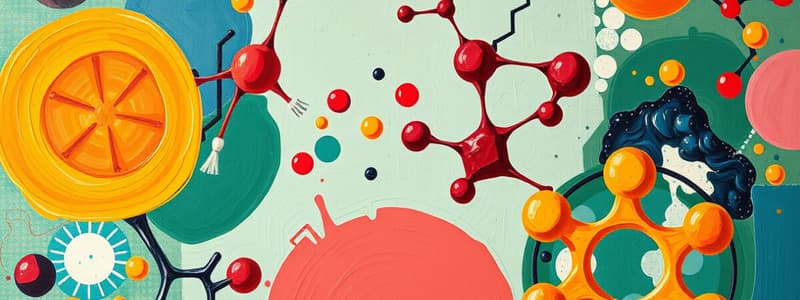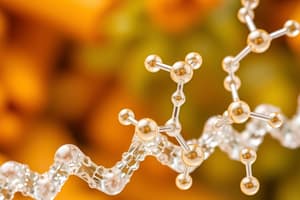Podcast
Questions and Answers
Which type of carbohydrate consists of two monosaccharides?
Which type of carbohydrate consists of two monosaccharides?
- Disaccharides (correct)
- Monosaccharides
- Polysaccharides
- Oligosaccharides
What term describes carbohydrates containing more than 10 monosaccharides?
What term describes carbohydrates containing more than 10 monosaccharides?
- Polysaccharides (correct)
- Oligosaccharides
- Trioses
- Disaccharides
Which of the following carbohydrates has an aldehyde as its most oxidized functional group?
Which of the following carbohydrates has an aldehyde as its most oxidized functional group?
- Glyceraldehyde (correct)
- Ribose
- Sedoheptulose
- Glucose
Which carbohydrate is classified as a pentose?
Which carbohydrate is classified as a pentose?
What functional group is associated with ketoses?
What functional group is associated with ketoses?
Which of the following terms refers to carbohydrates that contain 3 to 10 monosaccharides?
Which of the following terms refers to carbohydrates that contain 3 to 10 monosaccharides?
What is the general formula for carbohydrates?
What is the general formula for carbohydrates?
Which of the following carbohydrates is a triode?
Which of the following carbohydrates is a triode?
Which carbohydrate contains amino groups?
Which carbohydrate contains amino groups?
What is the key characteristic that distinguishes ketoses from aldoses?
What is the key characteristic that distinguishes ketoses from aldoses?
Which of the following sugars is identified as a deoxy sugar?
Which of the following sugars is identified as a deoxy sugar?
What role does Glucuronic Acid primarily play in the body?
What role does Glucuronic Acid primarily play in the body?
Which monosaccharide is not primarily associated with glycoprotein structure?
Which monosaccharide is not primarily associated with glycoprotein structure?
Which of the following compounds can be classified as isomers?
Which of the following compounds can be classified as isomers?
What is the primary function of glycogen in animals?
What is the primary function of glycogen in animals?
What distinguishes epimers from other stereoisomers?
What distinguishes epimers from other stereoisomers?
Which component is not a part of plant mannans and gums?
Which component is not a part of plant mannans and gums?
Which of the following sugars can be found in the hydrolysis of lactose?
Which of the following sugars can be found in the hydrolysis of lactose?
What role does D-Ribose primarily play in cellular functions?
What role does D-Ribose primarily play in cellular functions?
What is the chemical formula for the sugars classified as aldoses and ketoses?
What is the chemical formula for the sugars classified as aldoses and ketoses?
In the context of sugar metabolism, what process is phosphorylation mainly associated with?
In the context of sugar metabolism, what process is phosphorylation mainly associated with?
What describes sugar alcohols in relation to their structure?
What describes sugar alcohols in relation to their structure?
Which of the following statements accurately describes starch?
Which of the following statements accurately describes starch?
Which of the following carbohydrates is not considered a hexose?
Which of the following carbohydrates is not considered a hexose?
Which sugar is produced by the oxidation of the aldehydic carbon?
Which sugar is produced by the oxidation of the aldehydic carbon?
Which characteristic does not apply to stereoisomers?
Which characteristic does not apply to stereoisomers?
What is the primary feature of ascorbic acid?
What is the primary feature of ascorbic acid?
What potential health issue can arise from impaired metabolism of galactose?
What potential health issue can arise from impaired metabolism of galactose?
Which enzyme is responsible for forming glycosidic linkages?
Which enzyme is responsible for forming glycosidic linkages?
What is the primary source of energy derived from D-Glucose during muscle contraction?
What is the primary source of energy derived from D-Glucose during muscle contraction?
What is the characteristic of enantiomers?
What is the characteristic of enantiomers?
Which of the following best describes a D-sugar?
Which of the following best describes a D-sugar?
What role do racemases play in carbohydrate chemistry?
What role do racemases play in carbohydrate chemistry?
Complex carbohydrates can best be defined as:
Complex carbohydrates can best be defined as:
Which of the following is an example of a non-carbohydrate structure linked to complex carbohydrates?
Which of the following is an example of a non-carbohydrate structure linked to complex carbohydrates?
What kind of optical activity does a levorotatory (L) sugar exhibit?
What kind of optical activity does a levorotatory (L) sugar exhibit?
Which enzyme type is responsible for the formation of D-sugars from L-sugars?
Which enzyme type is responsible for the formation of D-sugars from L-sugars?
What is an N-glycoside?
What is an N-glycoside?
Dextrorotatory (D) sugars are characterized by:
Dextrorotatory (D) sugars are characterized by:
What is a defining feature of glycosaminoglycans?
What is a defining feature of glycosaminoglycans?
Study Notes
Overview of Carbohydrates
- Carbohydrates are the most abundant organic molecules in nature.
- Exist as polyhydroxylated aldehydes or ketones.
- Minimum structure requires at least three carbon atoms, a hydroxyl group, and typically an aldehyde or ketone.
- Classified into monosaccharides, disaccharides (two monosaccharides), oligosaccharides (three to ten monosaccharides), and polysaccharides (more than ten monosaccharides).
Types of Monosaccharides
- Triose: Glyceraldehyde (3 carbons)
- Tetroses: Erythrose (4 carbons)
- Pentoses: Include Ribose (5 carbons), vital for nucleic acids and as a coenzyme.
- Hexoses: Include Glucose (6 carbons), primary energy source; important for metabolism.
- Heptoses: Sedoheptulose (7 carbons).
- Nonoses: Neuraminic acid (9 carbons), important in cell recognition.
Key Functional Groups
- Can contain phosphate (e.g., UDP-glucose), amino (e.g., Glucosamine), or sulfate groups (e.g., Chondroitin sulfate).
- Aldoses have an aldehyde group (e.g., Glyceraldehyde).
- Ketoses have a keto group (e.g., Dihydroxyacetone).
Functions of Carbohydrates
- Provide energy and are storage forms (glycogen).
- Act as metabolic intermediates and form components of nucleotides in DNA and RNA.
- Contribute to cell membranes, immunity, and structural roles in organisms, such as cellulose in plants and chitin in shells.
Sugar Metabolism and Important Compounds
- Monosaccharides linked by glycosidic bonds.
- Initial step in sugar metabolism is phosphorylation.
- Glucosamine is derived from chitin, significant in insect shells.
- Galactosamine is found in polysaccharides such as cartilage.
Glycogen and Energy Storage
- Glycogen serves as the primary storage carbohydrate in animals, mainly in liver and muscle.
- Liver glycogen maintains blood glucose levels during fasting; muscle glycogen helps generate ATP for contraction.
Sugar Acids and Their Role
- Produced from oxidation of specific carbons (e.g., Ascorbic Acid and Glucuronic Acid).
- Glucuronic Acid is vital in proteoglycans and bilirubin metabolism.
Unique Sugars and Isomerism
- Deoxy sugars have a hydrogen atom instead of a hydroxyl group (e.g., 2-deoxyribose).
- Sugar alcohols result from the reduction of carbonyls in monosaccharides.
- Isomers have identical molecular formulas but different structures (e.g., Fructose, Glucose).
- Epimers differ at one asymmetric carbon (e.g., Glucose and Galactose are C-4 epimers).
Enantiomers and Their Importance
- Enantiomers are mirror-image isomers, defined as D- and L- sugars based on light polarization direction.
- D-sugars dominate in human biochemistry, with enzymes (racemases) facilitating interconversion.
Complex Carbohydrates
- Complex carbohydrates link to non-carbohydrate structures, such as nucleotides and glycoproteins.
- N-glycosidic bonds connect amino groups of non-carbohydrates to sugars.
- O-glycosidic bonds link hydroxyl groups of non-carbohydrates to sugars.
Studying That Suits You
Use AI to generate personalized quizzes and flashcards to suit your learning preferences.
Related Documents
Description
This quiz covers the structure and classification of carbohydrates in biochemistry. Focused on the number of carbon atoms and generic names, it includes examples like trioses and tetroses. Test your understanding of the foundational concepts related to carbohydrates.




